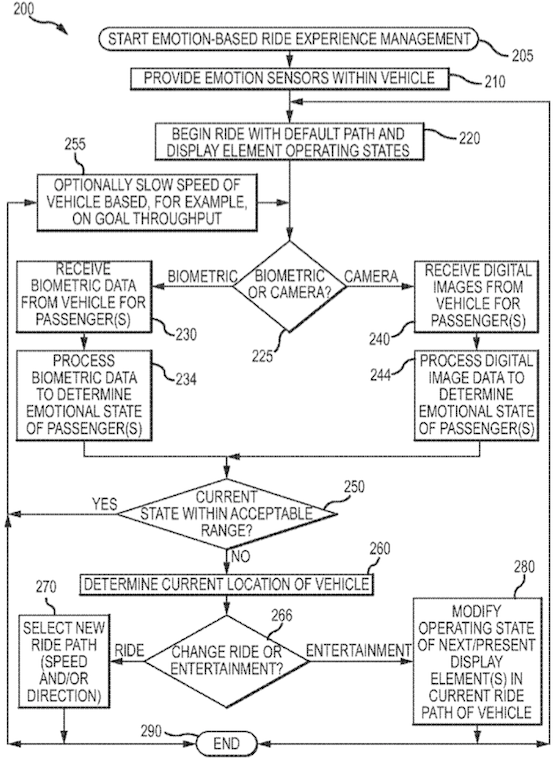Yes, it literally could be an emotional roller coaster.
Our colleague Richard Bilbao at the Orlando Business Journal found a Disney patent application for a ride system that would do just that.
Titled "Sensing and Managing Vehicle Behavior Based on Occupant Awareness," Disney's application describes a ride system "with a sensor mounted on an automated trackless vehicle... processing the passenger data to determine a passenger state at a particular point in time during the ride experience.... The method includes controlling the automated trackless vehicle to move off the first ride path and along the second ride path, e.g., to alter the passenger's state to enhance the ride experience."
Disney's application describes using cameras, biometric sensors, and RFID devices, along with "emotion/attention determination software" to process that passenger data to determine riders' state.
Essentially, the patent describes a passive "Choose Your Adventure" experience that reacts like an interactive attraction, without you actually having to do the interacting. Since companies try to write patents to be as expansive as possible while still being narrow enough to get the patent application approved, if you want to actively decide what elements you want in the experience, Disney's proposed system would allow you to do that, too.
Here's the flow chart, provided by Disney in its patent application:

Keep in mind that patent applications represent an early step in a long process of creating a new theme park attraction. Companies file patent applications more to cover their rear ends legally than anything else. As soon as someone inside the company develops a unique technical idea or approach, management needs to file a patent application for it ASAP, lest some other designer at another company come up with the same idea and patent it first, precluding other businesses from developing the same idea.
So maybe this is something Disney has in mind for a new ride we'll soon see... or maybe not.
But that doesn't stop us from imagining how such as system could work in a variety of settings. Theme parks never want you to feel bored when visiting, which is why they've spent so much money creating attractions that offer a different experience each time you ride, from The Twilight Zone Tower of Terror's multiple drop profiles to the ever-changing gameplay of Toy Story Midway Mania.
The ride system would take that concept to a new, much more advanced level, allowing it to adjust on the fly to riders' moods and schedules as well as their choices. That carries risk, of course. The system is only as good as the software that powers it, and the software is only as good as the decisions made by its developers.
My son and I share what we affectionately call a "resting b--ch face." Many people who don't know us read our expressionless faces as being angry or hostile. But that's not what we're feeling at all. If a ride system mis-reads us and send up through Candyland every time when we really want The Walking Dead, in an attempt to cheer us up, well, that's really going to make us mad.
The system also would need to accommodate the needs of riders on the autism spectrum, who would not react well to ever-changing triggers, but who could benefit greatly from a system that toned down the sensory overload when it recognized a rider who needed that. It's high risk, high reward all around here.
And of course, some riders would want to game this system by attempting to manipulate their expressions, the pulse rate or their skin temperature in an effort to get the ride to offer them a different path or story.
The easiest way for this system to work would be to employ a simple facial recognition feature, so it could recognize repeat riders and offer them a different experience than the last time they rode. But it's fun to imagine all the different ways that Disney could employ this system, and which IPs would provide the most useful match for it.
What do you think?
TweetDepending on mood, riders' "Trains of Thought" are hijacked by Joy, Sadness, Anger, Fear or Disgust, and taken through a different corner of Riley's mind.
Interesting concept for a theme park attraction. It certainly raises potential questions as Robert points out but there's great potential as well.
Wait....
What about frequent riders? Well, Magic Bands could be used to track which sequences guests have experienced, and the system could be set up to avoid returning to scenes a majority have already seen. In the above example, if guests make it to the third Fear scene before turning away, the next time they ride they could either start there or start at scene four when Fear is in charge instead of starting that path over at the beginning.
This article has been archived and is no longer accepting comments.